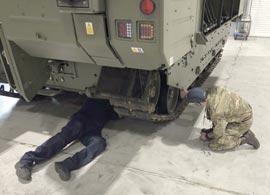
4 minute read
Support to Ajax
6 Armd CS Bn REME and HCR LAD

Advertisement


At less than 20 days’ notice to effect, a combined team of REME engineers and level 1 communication specialists from the 3rd (United Kingdom) Division deployed to the General Dynamics Land Systems-UK (GDLS-UK) production facility, Merthyr Tydfil, tasked with supporting the delivery timeline of the Ajax programme’s Initial Operating Capability (IOC). The complexities of integrating state-of-the-art military technology into the British Army’s first fullydigitised armoured fighting vehicle are challenging.
The exercise began in September 2020 with the main effort on accelerating the delivery of 12 IOC AJAX platforms to the Field Army. Engineers from 6 Armoured Close Support Battalion REME and the Household Calvary Regiment had very limited Ajax experience on arrival and were quickly required to learn and understand the technically demanding task of integration alongside experienced GDLS-UK personnel. Prior to an AJAX platform being accepted into service, it must successfully complete the authority’s General Acceptance Testing (GAT) process. The team conducted a rapid understand phase and audit of the extant processes ahead of completing 20 pre-GAT static vehicle inspections to the codified inspection standards. The intent was to improve the success rate of those presented for acceptance. Lead by WO2 (AQMS) Marks, the team rapidly integrated alongside GDLS-UK engineers at targeted points within the Ajax production facility where they could deliver the greatest impact.
Despite working on the Army’s most modern and complex piece of equipment for the first time, they were in no way fazed. The first sub-team integrated into Factory Acceptance Testing (FAT) to rapidly gain an understanding of FAT procedures, how they were being conducted and to scrutinise quality standards.
Once integrated, this sub-team conducted static inspections on all the vehicles critical to declaring IOC, documenting ‘snags’ and conducting rectification work to ensure the vehicles were in the best possible state before being presented to the Ajax Acceptance and Test Team (ATT) for GAT. Another sub-team joined GDLS-UK engineers in the post-GAT de-snag team to carry out rework identified during GAT inspections, whilst the HCR communication specialists focused on the complex platform Bowman LRU and cable installation process, subsequently conducting connectivity acceptance testing with the aim of identifying and rectifying issues prior to GAT inspection. Working closely with GDLS-UK’s quality assurance team, the team recorded all preGAT inspection findings into an online workbook and provided valuable feedback to the programme administrator to improve the process. This workbook provided a common database for snags to be recorded enabling fault trend analysis to be carried out, ultimately driving targeted improvements into the build process. Sgt Askem and Butler’s extensive JAMES experience enabled them to suggest



amendments to the workbook that streamlined its operation, enhanced data integrity and simplified the user interface. Capitalising on the significant data gathered from the inspection phase and in collaboration with GDLSUK, the team delivered a joint Learning From Experience (LFE) project. The project has improved the quality of both in-build and post-build vehicles, increasing the GAT success rate, reducing post-GAT rework required and therefore increasing the vehicle delivery rate to the Field Army. The pre-GAT inspection findings were jointly analysed to determine the root cause, before corrective actions were recommended and implemented within the production line to prevent reoccurrence. The team conducted confirmatory inspections to determine the robustness of the corrective actions previously implemented.
The deployment has been a tremendous opportunity for the Field Army, Army HQ, the Delivery Team and industry to collaborate for the collective benefit of the programme. It has exceeded expectations and offered substantial benefit to rectifying legacy quality shortfalls, whilst providing the opportunity for young soldiers to build invaluable knowledge on a fleet that will be in-service their full career.
The Vice President and General Manager of GDLS-UK, Carew Wilks stated: “The efforts of the team have made a significant contribution to the Ajax delivery programme. Their willingness to ‘lean in’ and to share their collective technical knowledge has had a positive impact on the GDLS-UK production workforce and the wider programme. I have been thoroughly impressed by their professionalism, commitment and enthusiasm and I thank them for their contribution to this complex programme, which will add a new and vital capability to the British Army”.
Matt Brown, the Ajax Project Manager, summarised the impact of the exercise: “Working hand-in-glove with industry since September 20, the team have strived to bring a different perspective and a fresh set of eyes to the significant engineering challenges faced in manufacturing and fielding all six variants of the new Ajax capability. As a direct result of their assistance General Dynamics Land Systems-UK and the Ajax Delivery Team have been able to deliver the first vehicles into service and de-risk fielding of the remaining variants. Along the way an exchange of ideas and collaborative working has helped to improve Quality Assurance processes and to apply additional rigour to the assembly, integration, testing and acceptance of this highly complex programme. This is a partnership that we very much hope will continue as we approach Full Operating Capability”.

BE RECOGNISED BE REWARDED

SSgt Andy Beacock EngTech MIMechE

Gain professional registration as an EngTech, IEng or CEng through a route specifically designed for REME personnel.
Enhance your military career Benchmark your skills and training Develop your professional network and connections
Apply now at imeche.org/armedforces For more support contact our Defence Liaison Ocer 07590 735816 dlo@imeche.org









